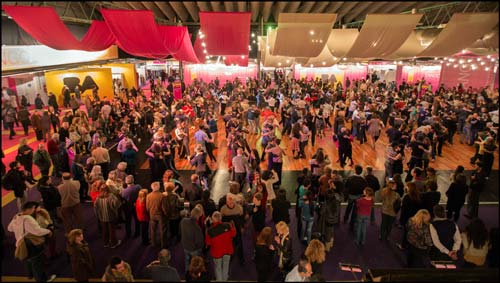By
Tango DJing - Part 1: Music for dancing

his is the first part of an article exploring Tango DJing. In this first part, we look at how music is structured in a typical milonga in Buenos Aires. Here you find the music played almost exclusively in tandas separated by cortinas.
A tanda is a set of songs of the same style (tango, vals, milonga, or something else). The purpose of a tanda is to let the dancers enter more deeply into an atmosphere and energy than is possible with a single song. For this reason, a tanda should be coherent: the songs are nearly always by the same orchestra, and from a similar period.
The cortina or curtain tune is a musical interlude that separates the tandas. It takes its name from the time when the curtain was lowered at a club in order to change the orchestra (e.g. from the tango orchestra to a jazz orchestra - an expensive cabaret might offer both in one evening). The cortina confirms to the dancers that the tanda is over, and as such its function is social, because this is the moment to change partners.
In a traditional milonga, everyone changes partners when the cortina comes, so the length of the tanda is social as well as musical - it is the length of time that the couple spends together. Tango tandas are normally four songs long; tandas of milonga, which is more tiring, three songs. Tandas of vals can be either. Whatever the DJ decides to do, it’s best if he sticks to his decision. Many of the dancers will be counting, so that they know where they are in the tanda.
The tanda is an indispensable ingredient of an authentic milonga, but let’s remember that it in the golden age the orchestras did not play in tandas for dancing. Initially, a tanda was often only two songs long - the two faces of a 78rpm record, although some clubs would play two records by the same artist, making a tanda of four. The tanda that we know today only became widespread in the early 1970s with the reissuing of old music on LPs. This made it much easier to play three or four songs in a row.

The tanda cycle
Experience has established that the following cycle of tandas works well: T - T - V - T - T - M
Keeping to a cycle like this gives the dancers a map of the evening. With three songs per tanda, each cycle of six tandas takes one hour; with tango tandas of four songs, the cycle takes around seventy minutes. This information also helps the DJ plan the evening.
This cycle is pragmatic because there are fewer valses and especially milongas than tangos. It is more difficult to be creative in the milonga tanda, as we are selecting from a much smaller pool of danceable tracks. This is not the only cycle: there are other possibilities. Remove one of the tango tandas, and the proportion of valses and milongas increases. This creates a more dynamic mood, but it means we have to find more valses and milongas, which can be difficult.
Until the 21st century it was still common to hear tandas of otros ritmos such as tropical (Argentine cumbia, or salsa), or swing, at many milongas. These might take the place of the milonga tanda and they helped to refresh the atmosphere. According to the testimony of Alberto Podestá and others, in the 1970s the milongas played 50% tango and 50% otros ritmos (other rhythms). The idea that an authentic milonga only plays tango music is relatively new.
In the 1990s it was still common to hear tandas of otros ritmos at many milongas. As late as 2006, when the city government passed a law (B.O.C.B.A. N° 2537) intended to support milongas, this stated: that the tanda of otros ritmos was a «fundamental part» of a milonga. Today (2015), most milongas do not play any otros ritmos. Many less experienced dancers, never having heard otros ritmos at the milonga, are under the impression that a traditional milonga only plays tango music.
What is the DJ doing?
The DJ is there so that people can express and enjoy themselves with other people through dancing. The music must make people want to dance - it must be good for dancing, and not too unfamiliar to the people in the room. The DJ is also managing the energy level in the room. Music is energy and feeling. Each tanda puts a new energy onto the floor and creates a distinct mood. The DJ has to find the right energy level for each moment of the evening.
DJing is also an act of sharing. Music is emotion, and the DJ is sharing their feeling for the music with the dancers. He or she is in relationship with them, and all successful relationships depend upon trust. Many experienced DJs have told me that building trust with the public is fundamental.
In the next part of this article we will look at how the DJ builds a tanda.